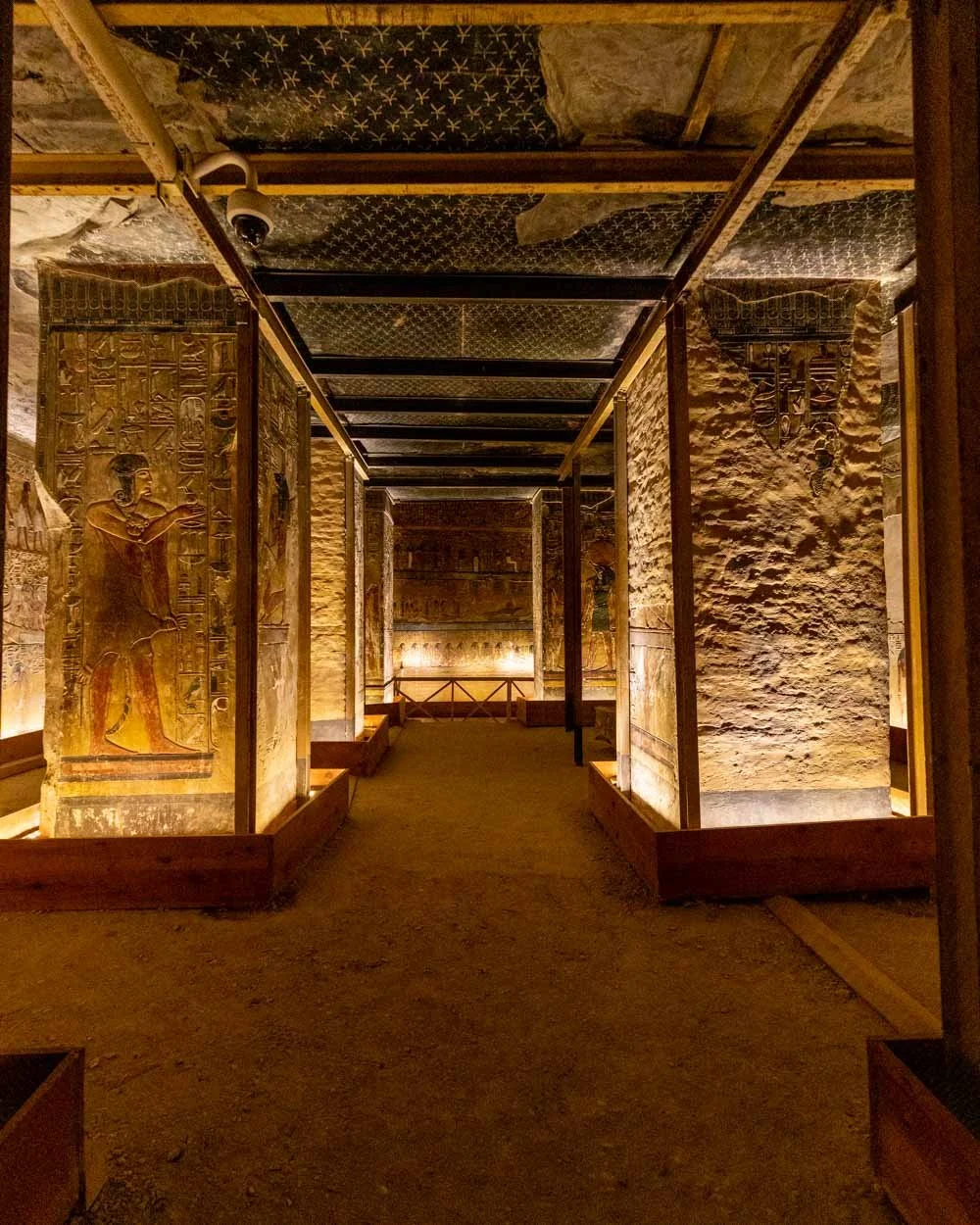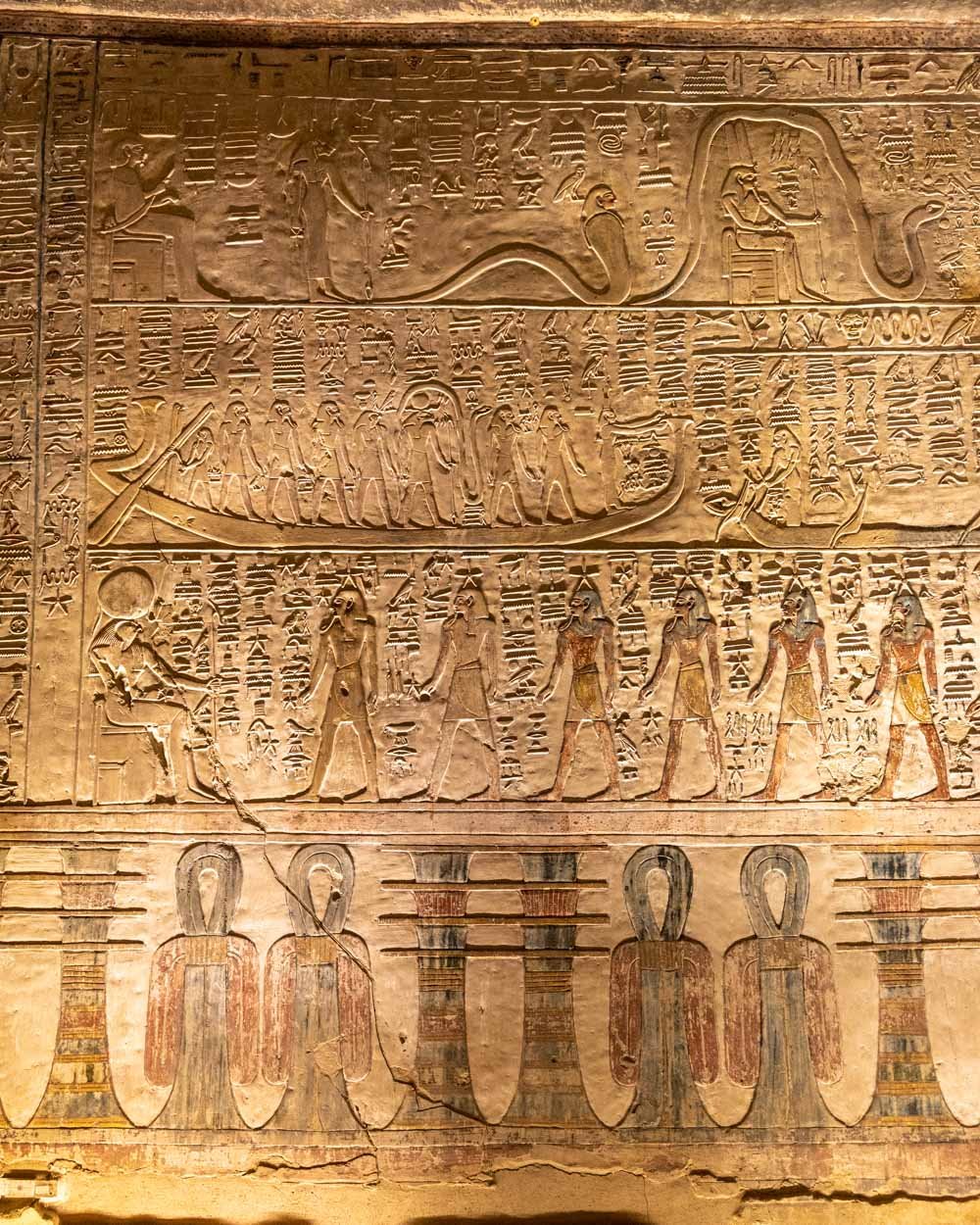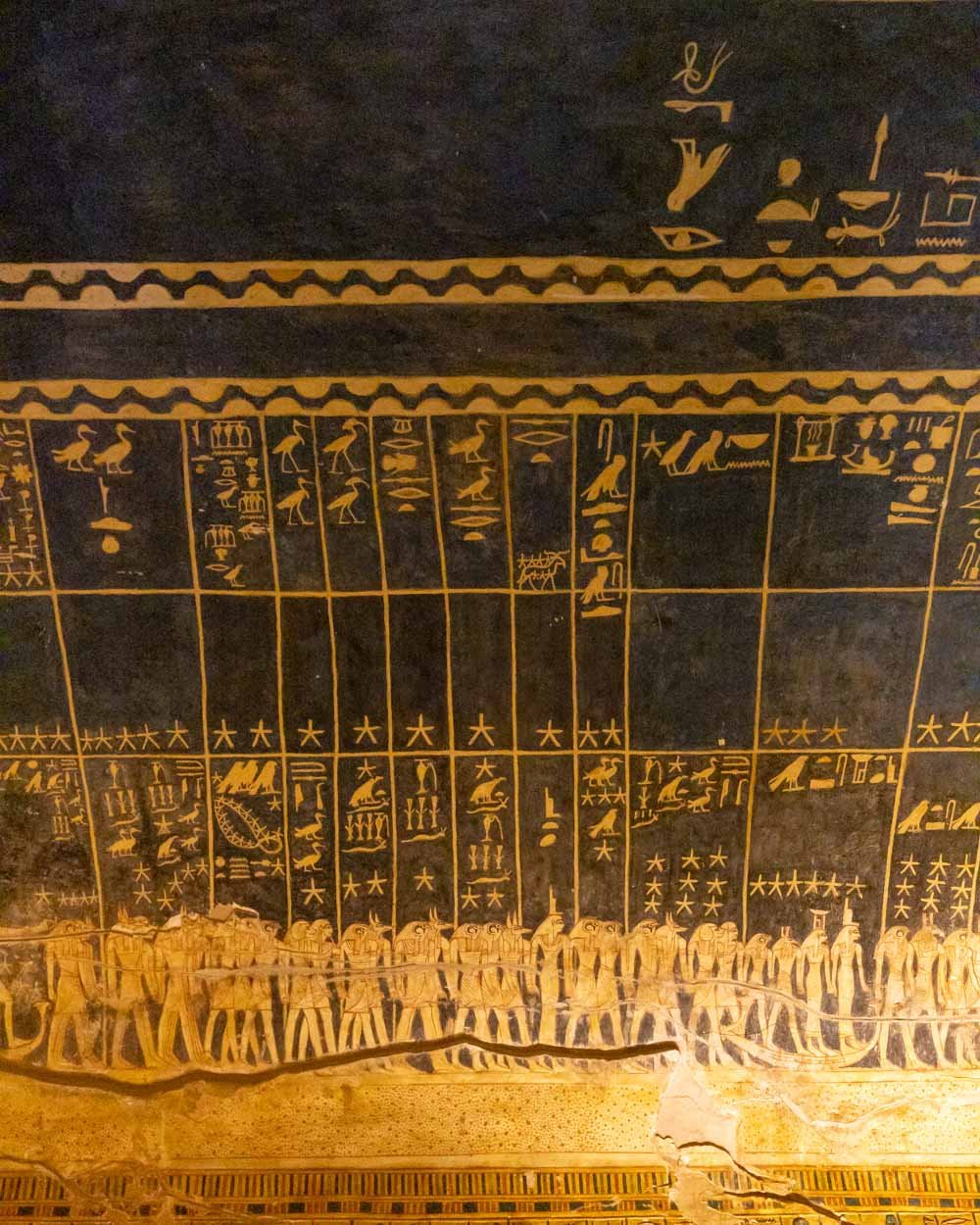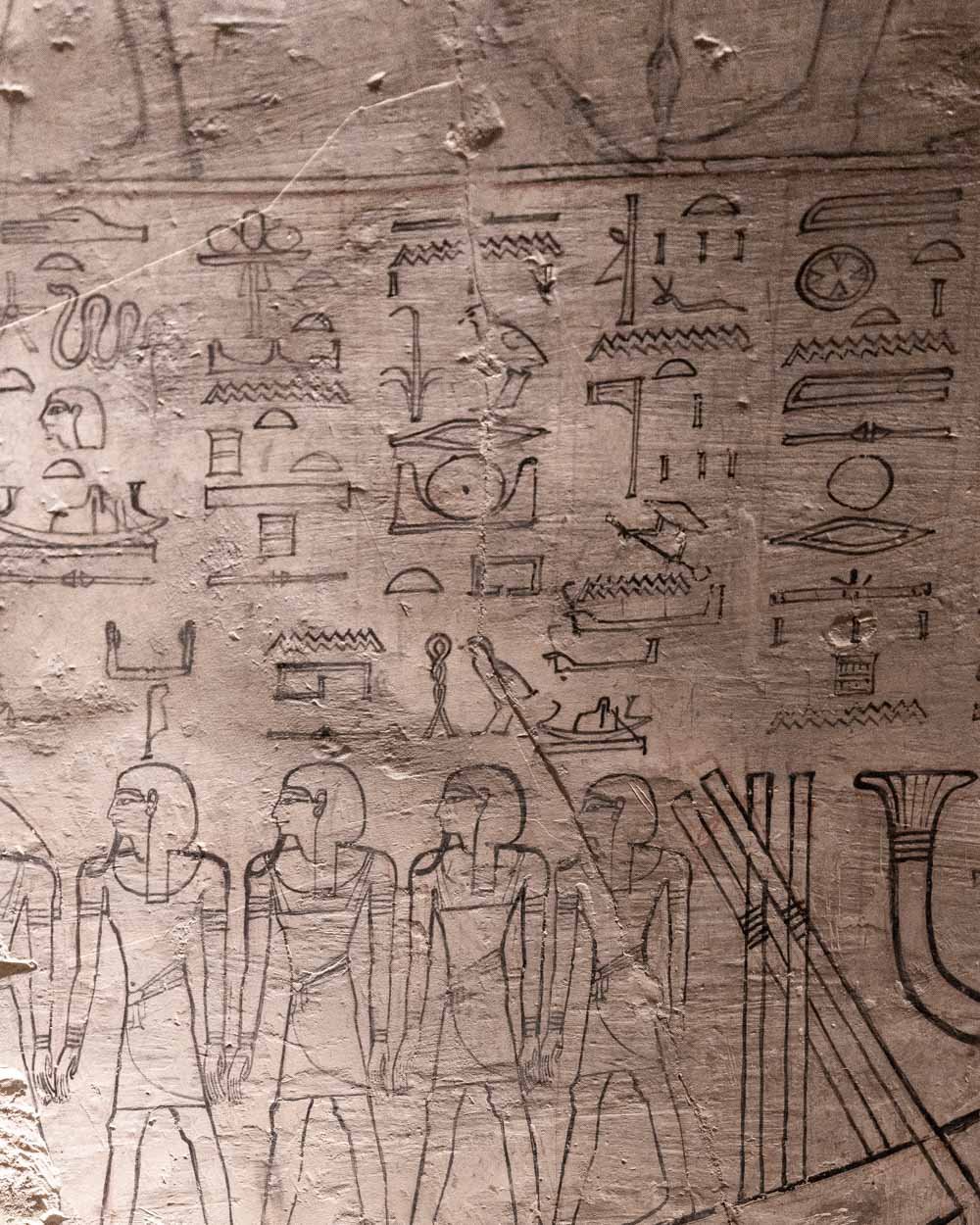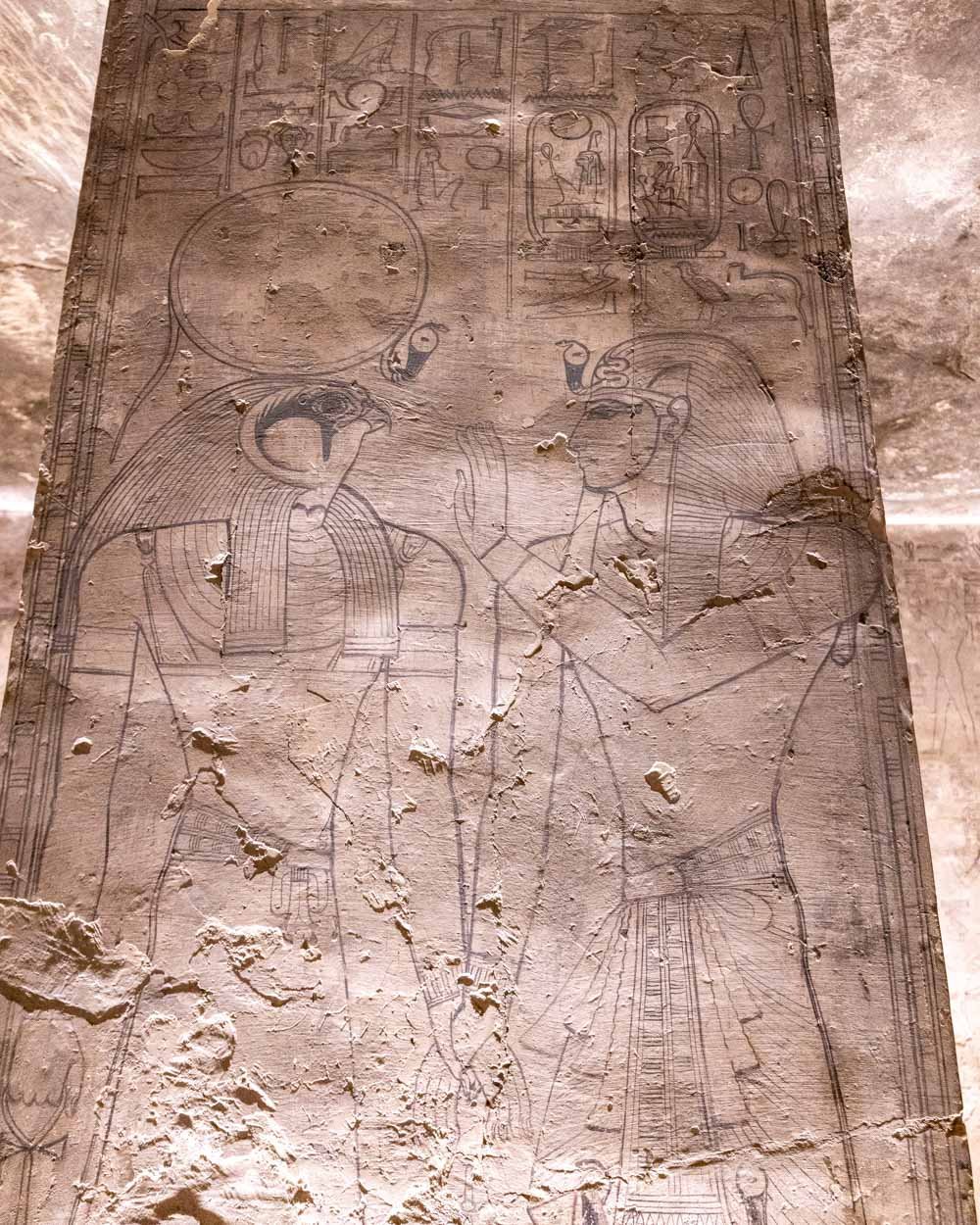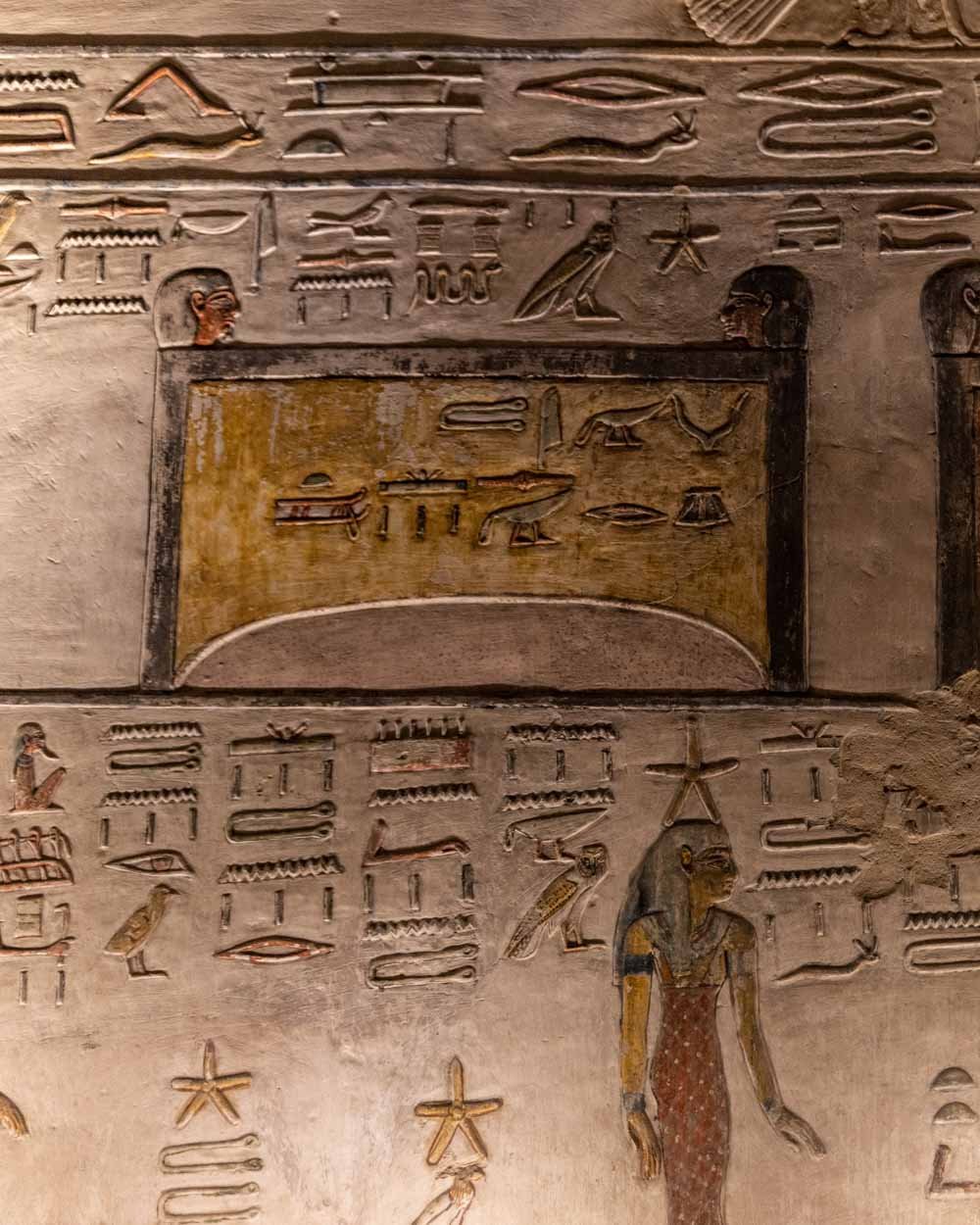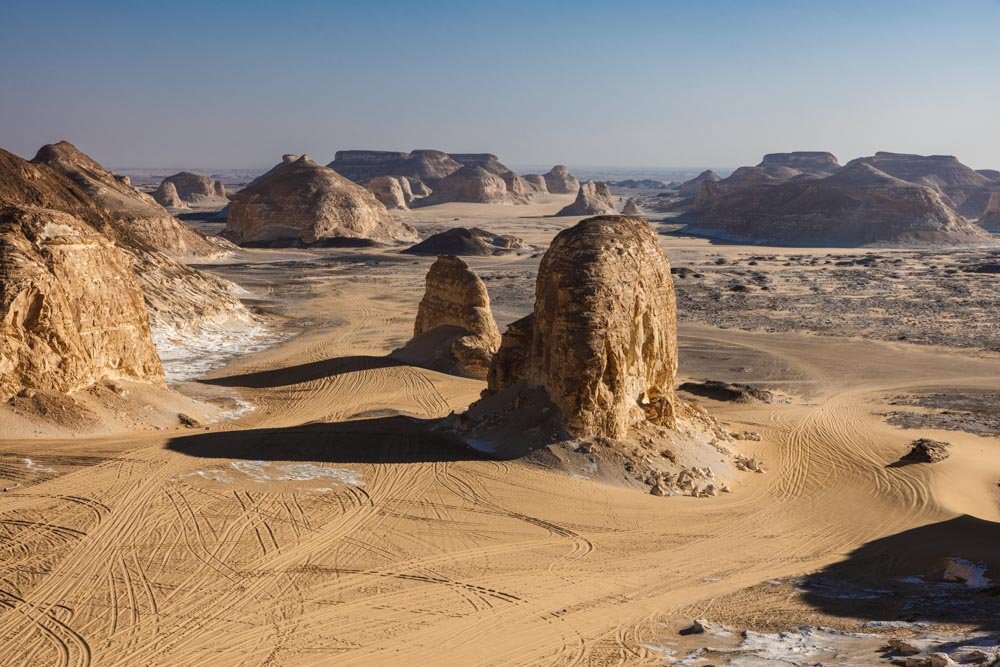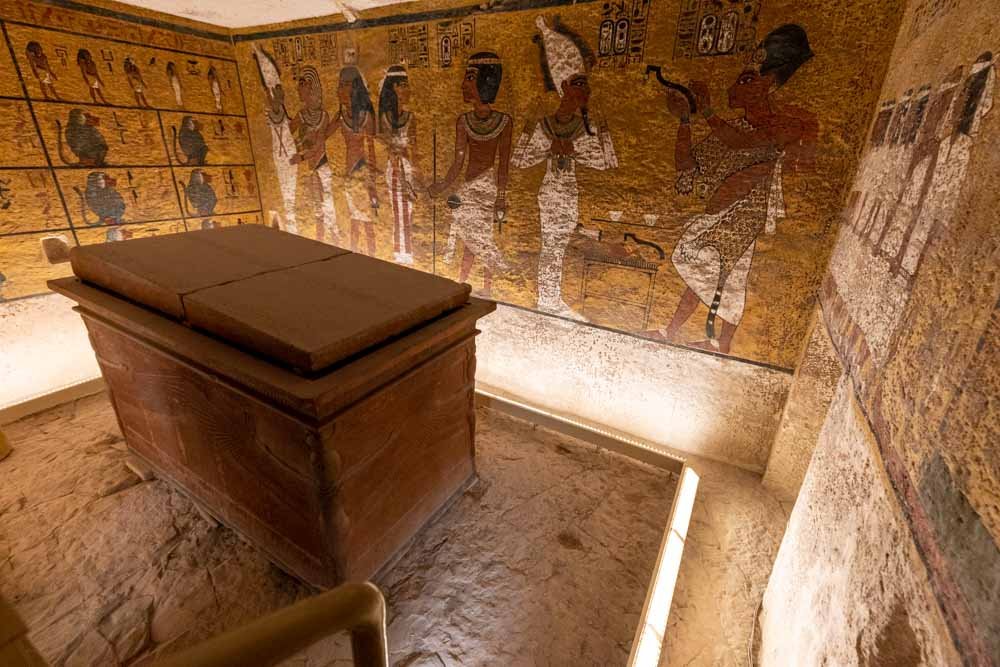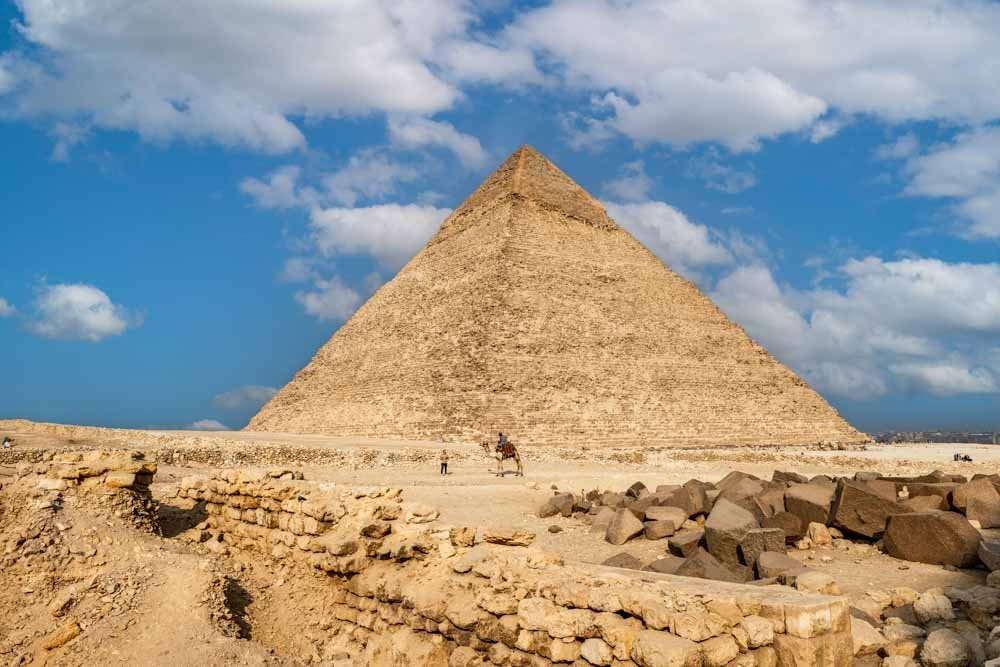The Tomb of Seti I is the premier tomb in the Valley of the Kings and much like Nefertari's tomb in the Valley of the Queens, it comes with a hefty price tag. In fact the first time I saw the price, I actually thought it was a typo. At 1,400 EGP (USD $45 at time of writing, but USD $60 before the currency crash), it is more than three times the cost of the Valley of the Kings entry fee, which gets you into three tombs. It’s also more than treble the cost of the much more famous tomb of Tutankhamun.
So we’ve established it’s one pricy tomb, but despite that, we knew we had to visit. Any single tomb that is considered so special as to be that much more expensive than all 11 others in the valley combined sounded too good to miss.
But was it worth it? We’ll give you the verdict, plus the full low down on what to expect inside the tomb and what art to look out for.
Seti I Tomb
The experience & the layout
We were exceptionally lucky that we visited Seti I’s tomb towards the end of the day, which is what we’d highly recommend anyone to do (or first thing when it opens). We were the only ones in the tomb for the entire time, which enhanced our experience in every way.
The tomb is located 260m from the entrance to the valley and it’s an easy walk to reach it.
It is a huge tomb, and the deepest in the valley, with 13 sections (rooms and corridors). Venturing into its depths feels like straying on to the set of Indiana Jones.
You can see just how big it is from the map below.
Once you get to the entrance of Seti I’s tomb, you’ll have two sets of stairs to descend before you hit the wooden ramps, which have slats to make descending easier. As it is such a deep tomb, it’s one of the more difficult ones in the valley to access if you’re not comfortable with descending and ascending several steep staircases.
Exploring the tomb
The first pillared chamber you’ll see is interesting, but nowhere near as well preserved or impressive as the golden burial chamber, which you’ll get to when you descend a few more stairs.
Before you head to the burial chamber, make sure you check out the side chamber with all the stencils. It is well worth a look to get an insight into how the paintings were made.
The stencils in the side chamber
The first chamber
From the first chamber, you’ll take a set of stairs down to another corridor that leads to the burial chamber. This is when the tomb becomes truly awe-inspiring.
The chambers are low lit, so it’s incredibly atmospheric. The light is enough for you to see the detail in each painting, but dark enough that it has that mysterious feel.
I loved the atmosphere of the tomb and it’s exactly how I dreamt tomb exploring in Egypt would be.
The burial chamber
This was also helped by the fact that there was no one else there. When we weren’t moving around or letting out frequent ‘wow’s’, the silence was absolute. If you’re lucky enough to also get the tomb to yourself, it’s an experience you won’t forget.
Side chamber jb
It’s worth noting that it wasn’t overly warm like some of the other tombs were, which definitely makes spending a long time inside much more comfortable (although that could be due in part to the fact there was no one else inside the tomb).
The Tomb Guardian
As with all the tombs in the Valley of the Kings (and Queens) there will be a tomb guardian present. They can at times follow you and be a bit pushy about showing you things in order to get tips.
It’s something we fully understand as they are paid poorly and rely on tips, but it is a bit of a wearing experience when you just want to immerse yourself in the paintings.
Luckily for us the guardian at Seti I’s tomb was not like this. He actually enhanced our experience by letting us have space, but then also pointing out interesting pictures and letting us into some of the roped off rooms. The roped off rooms are three side chambers, with the best being on the far left (side chamber jb).
If you are assisted in any way by the tomb guardians, you will of course by expected to tip, which we were more than happy to do.
Although we weren’t sure if the rooms are always roped off, or roped off in order for the ropes to be removed to get tips, but either way it didn’t really matter as it was still a wonderful experience.
The paintings inside the roped off chambers are not as impressive as the ones in the main chamber, but still fantastic, and we were glad to be able to see them up close.
All in all our experience inside the tomb of Seti I was my favourite of the 18 tombs we visited in Luxor (which included the more expensive tomb of Queen Nefertari).
The paintings
We visited every single tomb open to the public in the Valley of the Kings during our visit (12 in total), so we feel confident in saying, there is no tomb in the Valley of the Kings quite like the tomb of Seti I.
But I am guessing you already assumed that given the price tag, so it really comes down to how much better those paintings are.
The paintings are exceptional and the tomb is absolutely huge, so the number of them is also vast. They are for the most part spectacularly well preserved and detailed.
As with all tombs, there is some damage, but honestly not much at all considering the paintings are over 3,000 years old.
There are so many that you could spend days in the tomb and still notice new details. We spent an hour exploring and honestly I could have stayed longer!
The detail, vibrancy and sheer number of chambers to explore was incredible. There is no glass at all in Seti I’s tomb, so there’s nothing between you and the paintings, which makes it much more absorbing. There are plenty of other tombs without glass too, but I wonder in time if glass will be added to keep the paintings as pristine as they are now.
Here’s a few of our favourite paintings to keep an eye out for.
Art to look out for in Seti I’s tomb
The ceiling of the burial chamber
The walls of the burial chamber are spectacular and in superb condition. This is the room we spent the longest in as it had so much to see. You’ll see images from the Book of the Dead covering the walls, it’s essentially an instruction manual for Seti I’s soul to follow in order to pass into the underworld.
However, it was the ceiling that really surprised us. It’s full of astronomical scenes, with many delicate hieroglyphs, as well as gods and animals. The ancient Egyptians believed the sun was born every day in the east and died in the west, an eternal circle of life. The art on the ceiling is there to show Seti I’s soul how to replicate the path of the sun god in order to achieve eternal life.
It’s also the only place we saw depictions of the hippo god Taweret and Sobek in the Valley of the Kings.
The Stencils
Stencils are quite rare in the Valley of the Kings, as they’re only present if the tomb is incomplete - a sign of a pharaohs premature death.
It offers an insight into how the tomb paintings were made, with three sets of artists involved: the first draw rough outlines in red, followed by more skilled artists adding more detail in black, and finally the most skilled paint rich colour on top.
In Seti I’s tomb there are numerous examples of unfinished art, starting with an incredible stencil of a jackal on the first set of stairs leading into the tomb.
More significantly, there is a huge room of stencils just off the first pillared chamber. You can see many depictions on the walls and even the outlines of gods on the pillars.
The only other tombs we saw stencils like this in were Tausert/Setnakht and Seti II, but there weren’t as many.
The bizarre depictions in side chamber jb and the first pillared chamber
If you’re lucky, the tomb guardian will allow you into what’s designated as “side chamber jb”, which is a tiny room off to the left of the main burial chamber.
The eagle-eyed will see all kinds of bizarre scenes, including heads hanging on poles and what looks like two people laying in boxes. I’m sure Egyptologists will have answers for what these depict, but we couldn’t decipher the meaning.
You’ll also see some similar art in the first pillared chamber, with lines of what look like the entrails of a mummy being pulled from the body. If you know what this is meant to symbolise, please let us know as we haven’t been able to find out!
Photography inside the tomb
Rules regarding photography change constantly in Egypt. We got very lucky, and photography with any type of camera was allowed in every tomb for free. This was my third visit to Egypt and sometimes all photography is allowed, sometimes only cellphone photography and sometimes none whatsoever.
Don’t make the mistake we did at the Great Pyramid and leave your camera behind trusting what’s written on the internet - things change too often for that. Bring your camera and if the rules have changed, you can just put it away, or maybe pay a little baksheesh….
The verdict: is the tomb of Seti I worth it?
I think it’s probably fairly obvious at this point that my answer is yes! We did get lucky with a perfect experience inside the tomb, but honestly the paintings, scale and atmosphere of the tomb are hard to beat.
It is very expensive for a single tomb, but it doesn’t come with a time limit and it’s cheaper than Queen Nefertari’s tomb, which comes with a 10 minute time limit - so it does feel better value (although the paintings in Nefertari’s tomb are the most impressive of any tomb in our opinion).
If you decide that it is too expensive, then definitely make sure you visit the much cheaper, but still fabulous tomb of Rameses V&VI - at time of writing it’s only an additional 120 EGP (USD $4) and it was another of the very best tombs in the valley.
The tomb of Rameses V/VI
If it’s detailed paintings you’re looking for in particular, you shouldn’t opt for Tutankhamun’s tomb which only has three small painted walls - though it very much has its own special features!
Tutankhamun’s tomb
If you are going to visit the tomb of Seti I, depending on the exchange rate, you may be better off buying the premium Luxor Pass. When I first looked into the pass, Seti I’s tomb equated to USD $60. Nefertari’s tomb in the Valley of the Queens was USD $87.
The two combined almost covered 3/4 of the cost of the premium Luxor Pass alone. This makes the tomb feel less expensive. However when we actually got to Egypt, the Egyptian pound had fallen hard against the dollar. Seti I’s tomb became USD $45, which is better value if you’re buying it alone, but made the pass poorer value. So do watch for the exchange rate as it can make a huge difference to whether buying the pass is worth it.
Currently to make the pass worth it, you must be planning to visit all premium tombs and spend several days taking in all of Luxor’s historical sights. Don’t buy the pass without first checking the exchange rate.
The history of Seti I
Seti I was the second pharaoh of the nineteenth dynasty in the New Kingdom, and son of Rameses I. Seti I is seen as one of the great pharaohs of Egypt, reigning for 12 years, and his reign set Egypt on the trajectory of transitioning from instability to a golden age.
The reign of Akhenaten 50 years earlier had created chaos, changing the religion of the country and creating an economic downturn. The succeeding pharaohs reinstated polytheism, but it wasn’t until Seti I that Egypt began to regain its former glory.
Seti I was very successful not only in bringing about order and economic prosperity, but also military victories, which re-established Egyptian sovereignty over its previous territories. His victories are depicted on the walls of the spectacular Hypostyle Hall in Karnak Temple in Luxor, a place that we highly recommend visiting (it is particularly atmospheric at sunrise or sunset).
Seti I’s success was continued by his son Rameses II, a pharaoh who is often regarded as one of the greatest in ancient Egypt.
The discovery of Seti’s tomb
The discovery of Seti I’s tomb is up there with the greatest archaeological discoveries. It was found by Giovanni Belzoni, an Italian explorer who was backed by the British to uncover new tombs in the Valley of the Kings. In 1817, he started searching in an area many thought was a lost cause, a place prone to flooding and landslides
However, he uncovered the incredible tomb of Seti I which was lauded across the world. It’s stated that the French were so angry that Belzoni had helped the British uncover the tomb, that they opened fire on him! He eventually retreated to London, creating an exact replica of the tomb, which fuelled Egypt frenzy within the British public.
Getting to the Valley of the Kings
Assuming you don’t want to visit on a tour, you can easily hire a taxi in Luxor, or at the ferry terminal on the West Bank. You’ll need to haggle, and make sure you state the wait time you want included. Visits to the Valley of the Kings are usually made in conjunction with the Valley of the Queens and other sites on the West Bank.
How much you pay will depend on how much you want to haggle and how far away you can negotiate from a big hotel. If you’re hanging around places like the Hilton, it’s hard because the drivers all have the rates the hotel charges (600 EGP for 5 hours at time of writing). This is much more than you can pay by negotiating with a driver directly and as I say, preferably not near an expensive hotel!
The cheapest we were offered pre-haggling was 400 EGP - note that we were travelling at a time when the Egyptian pound had been severely weakened against the US dollar, so prices in EGP were higher than they had been previously.
The journey between Luxor and the Valley of the Kings takes around 50 minutes. It’s much quicker if you take the ferry. You should get a cheaper taxi price from the West Bank, but we always went from Luxor city.
This post may contain affiliate links, meaning at no additional cost to you, that we will earn a small commission if you click through and decide to make a purchase. This helps towards the costs of running our website. Thanks for your support!

